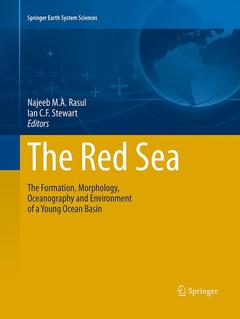Description
The Red Sea, 2015
The Formation, Morphology, Oceanography and Environment of a Young Ocean Basin
Springer Earth System Sciences Series
Coordinators: Rasul Najeeb M.A., Stewart Ian C.F.
Language: English
Subjects for The Red Sea:
Keywords
Publication date: 11-2016
Support: Print on demand
Publication date: 04-2015
638 p. · 21x27.9 cm · Hardback
Description
/li>Contents
/li>Biography
/li>Comment
/li>
This book presents a broad overview of the current state of knowledge regarding the Red Sea, from its geological formation and oceanographic development to the environmental influences on its ecology and the changes it is experiencing due to the rapid development of its coastlines and role as one of the world?s major transport routes. The book gathers invited contributions from researchers with an interest in the geology, geophysics, oceanography and environment of the Red Sea, while also providing comprehensive new data and a complete review of the literature. It will be of interest not only to researchers actively studying the sea and its surroundings, but will also appeal to all those involved in planning and managing the Red Sea, its environment, its resources and the countries which rely on its existence.
e-mail: rasul.nm@sgs.org.sa
Dr. Ian C.F. Stewart, Saudi Geological Survey, Jeddah, Saudi Arabia
e-mail: Stewart.IC@sgs.org.sa
Contributions from active researchers providing up-to-date summaries of their fields of interest
Presenting data and diagrams not generally available previously
Vital resource to all those involved in planning and managing the Red Sea, its environment, its resources and the countries which rely on its existence
Includes supplementary material: sn.pub/extras




